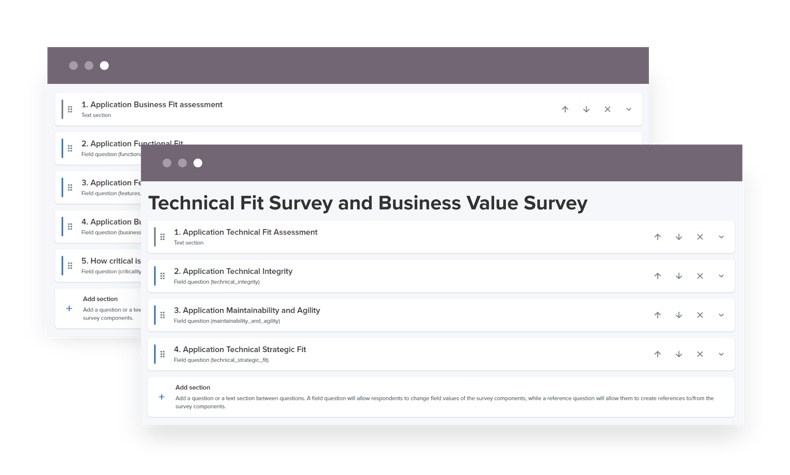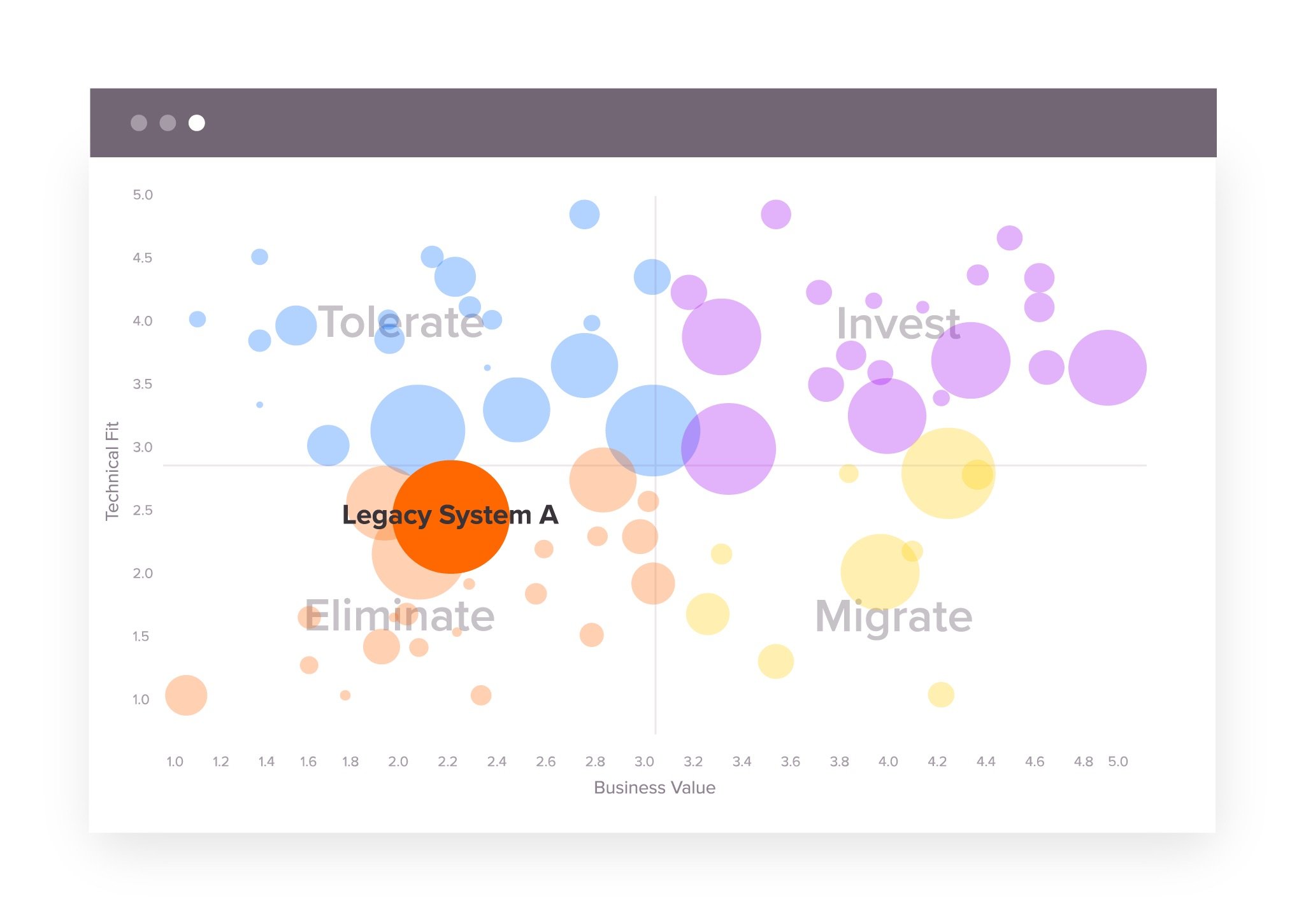Do you have full control of your enterprise’s applications? Do you know which ones are providing the best value or which ones are candidates for retirement, replacement, or migration? If you are unsure, then it’s time to evaluate your application portfolio. A successful application portfolio assessment generates insights that will help you improve your technology landscape.
Businesses rely heavily on applications to streamline operations, enhance customer experiences, and generate revenue. However, as organizations evolve, the application portfolios grow and can become unwieldy. Applications get outdated and redundant, and then struggle to keep up with the organization's need for innovation and change. If left unchecked, this leads to duplicate functionality, IT overspend, and sub-performance.

Regular assessments as part of Application Portfolio Management (APM) takes top priority for IT leaders and enterprise architects. Enterprise Architects evaluate sets of applications and determine their value based on multiple criteria. They then can recommend ways that the organization can generate more value, save costs, and run more efficiently.
Create an Effective Application Portfolio Assessment
There are various techniques that will make your application portfolio assessment as effective as possible. Let’s look at each of the four steps of an application portfolio assessment and see what is involved.
Step 1: Define Your Application Portfolio Objectives
A successful application assessment starts with clear objectives. The team needs to ask themselves:
- What are the outcomes you want to achieve?
- How will you measure them?
- Who are key stakeholders?
- Why are you doing it? Are you doing an assessment to cut costs, boost innovation, or clean up outdated technology?
- Is it necessary to modernize a business process, or is this information the foundation for planning a multi-year IT strategy?
By working through these questions, teams can better set the assessment’s scope, budget, and timeline. Then you can draft a plan - even a simple slide deck - to help you set the right expectations amongst your colleagues, and get buy-in from senior leaders and decision-makers.
Some examples of the outcomes you may want to achieve include:
- Lowered Application Portfolio total cost of ownership (TCO)
- Reduced maintenance costs associated with the Application Portfolio
- Reduced number of applications per business capability
As a general rule of thumb, it is best to keep the assessment to as small a scope as possible. Focus on one business capability or business area at a time and then expand the scope at later dates.
Step 2: Take Stock of the Application Portfolio
Now it’s time to get an overview of applications and gather the data needed to carry out an assessment. This involves collecting basic information like application name, description, and owners, and then building out your data set to help you evaluate the applications and assign them a strategic ranking.
Even if you have an application inventory, do a quick check to see if any applications are missing. Your colleagues may have purchased software without involving IT. A simple survey can help you uncover unmapped applications and ensure they are included in your assessment. You don’t want assessments to be based on missing data.
Collect more details about how applications are connected to the business, their functions, criticality, usage, technical attributes, and integrations. Make a list of questions that will enable you to evaluate the application’s business and technical values.
Some of the data you need will likely be spread across various places, including spreadsheets, configuration management database (CMDBs), or even in the heads of application owners, solution architects, and developers. In any case you should pull this information into a central place and enhance the data to make sure it is complete and up-to-date.
This step may sound tedious, but there is no avoiding it. Although it is a critical step, you can simplify the process and ensure higher data quality, using specialized Enterprise Architecture tools. Below is an example questionnaire application owners or other stakeholders should be sent to on scheduled basis to assess business fit and technical fit:

Ardoq Quick Start provides an easy way to start your Application Rationalization and Application Lifecycle Management journey using clear guidance and easy templates. Reduce IT complexity and deliver IT cost savings in just 30 days. Book a demo now and see how much you can save.
Step 3: Calculate Strategic Rankings
Now that you have a clear view of business goals and baseline data, you can score each application's Business Value and Technical Fit. What are the highest scorers, and which ones are poor performers?
The scores are calculated based on multiple criteria. You decide how to weigh the criterion, which will vary depending on your organization.
Strategic Rating = Business Value measured against Technical Fit
The business fit and technical fit are measured on a 1-5 scale.
Business Value
Business value measures how well the application achieves the goals of a department or organization. The value is determined by considering an application's effectiveness, mission criticality, utilization, complexity, and usability.
Technical Fit
Technical fit measures how well the application supports the current technical needs and future needs of the service organization. The technical fit is determined by considering technical requirements, security standards, software and hardware version control, dependencies, scalability, and adaptability.
Step 4: Assess the Application Portfolio
The Gartner TIME model (Tolerate, Invest, Migrate and Eliminate) provides a solid framework for analyzing your portfolio. Plot the business value and technical fit scores into one of the four categories:

- Tolerate: These high-quality applications require little time or money to keep, but provide low business value. Phasing them out would waste time and resources, and the cost could potentially be higher than the support cost.
- Invest: Applications that you want to keep. They are high-quality, stable applications that provide high business value and don’t require a lot of support.
- Migrate: These are applications your IT team dreams of getting rid of. While these applications are providing business value, they are not meeting IT requirements. Their support costs are high and are likely to make the business vulnerable to security risks. Therefore, it is better to migrate those applications.
- Eliminate: These applications are low quality and provide low business value. They are most likely legacy applications, with very few people using them.
This visual representation will help you make recommendations and guide discussions about each application's future within your organization. For example, applications in the ‘Eliminate’ quadrant are candidates for consolidation and removal from the application portfolio. In contrast, the ‘Invest’ quadrant contains candidates for improvement and further development due to their value to the organization.
Gather information about application costs and risk data for a more detailed analysis. This data helps you prioritize initiatives and make long-term versus short-term trade-offs.
Improve Your Application Portfolio with New Enterprise Architecture
Some organizations conduct formal, annual portfolio assessments. However, as the pace of change accelerates, businesses are under increasing pressure to monitor their applications for technical and business fit continuously. This involves shifting from manual routines to automated processes that keep portfolio assessments, application owners, and other key stakeholders up-to-date and structured. The higher the level of automation, the easier it is to evaluate and optimize IT environments continuously.
As you do each application portfolio assessment, look for ways to improve your workflow, enable self-service, and communicate better with your teams. You’ll be glad you did.
Ready to get started? Download our guide: 9 Steps to Application Portfolio Management:
